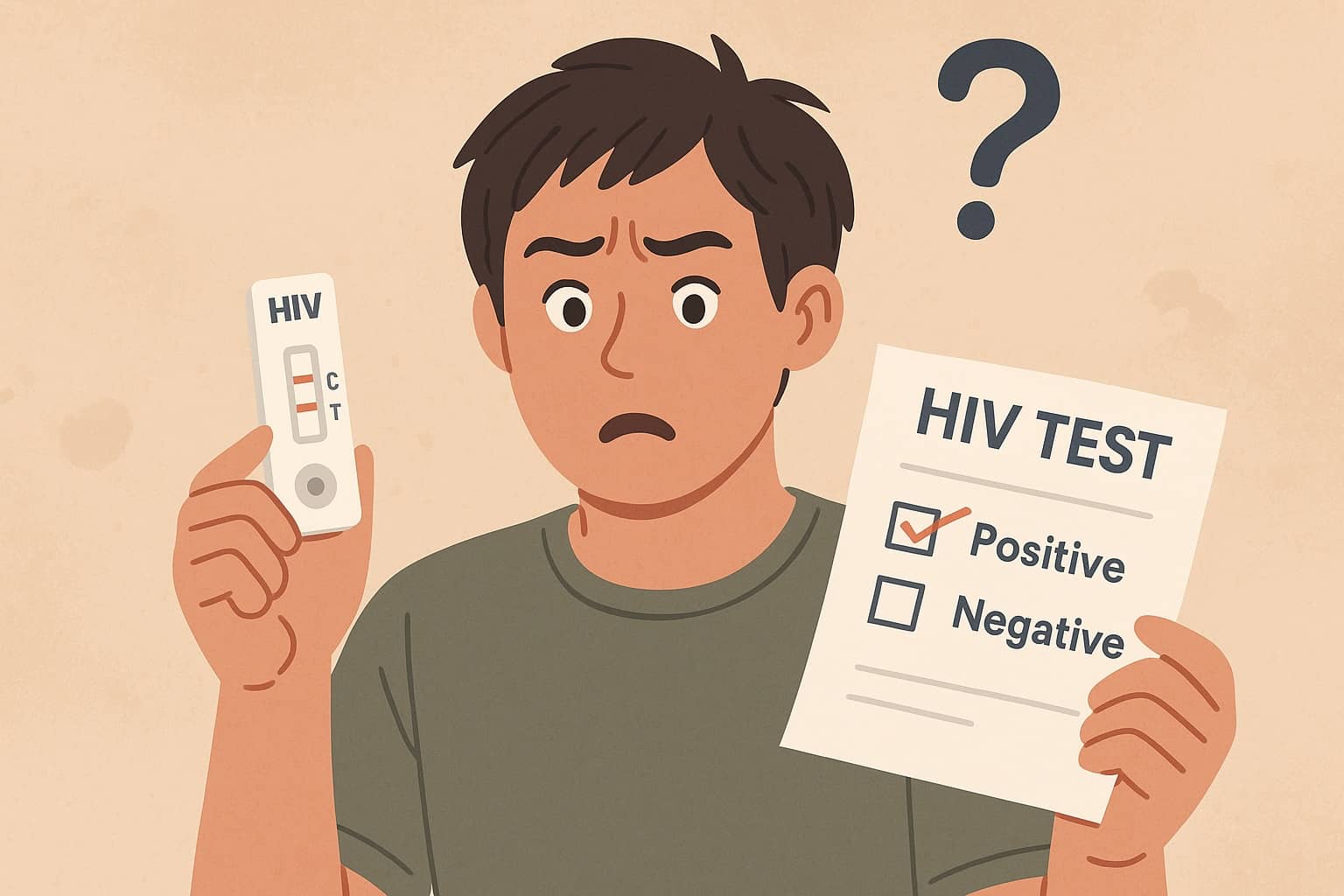Getting a HIV test can feel stressful, and receiving unclear or unexpected results can heighten anxiety. It helps to understand the terms “false positive” and “false negative,” what they mean, why they happen, and crucially, what steps to take afterward. This guide provides clarity on both false positive and false negative HIV results, balancing technical explanation with practical advice.
Understanding HIV Testing: The Basics
Types of HIV Tests Available in Singapore
In local clinics and hospitals, you’ll commonly find the following testing options:
- Rapid HIV Tests: These tests produce results in 15 to 30 minutes and are available at many private clinics. They are typically finger-prick tests that detect HIV antibodies and/or antigens. Suitable for people past the window period who want quick answers.
- Lab-Based 4th Generation Tests: These tests detect both antibodies and the p24 antigen and are more sensitive during early infection. Blood samples are sent to a lab and results are returned in 1 to 3 days.
- HIV RNA Tests (NATs): Offered at select clinics, these detect the virus itself and are useful within 10 to 14 days post-exposure. They are more expensive and typically used for high-risk exposures or when early infection is suspected.
Each test has different ideal timing based on the window period. For most accurate results, your healthcare provider will guide you to the right test based on your risk level and timing of possible exposure.
HIV tests have evolved to become highly reliable. The most commonly used tests today include:
- Antibody tests, which detect the body’s immune response to HIV.
- Antigen/antibody tests, which look for both antibodies and the p24 antigen.
- Nucleic acid tests (NATs) or HIV RNA tests, which detect the virus’s genetic material directly.
These tests are usually over 99% accurate, but no test is flawless. Issues can arise due to timing, immune response, or technical factors (CDC, 2023).
To understand where false results come in, it helps to know two terms:
- Sensitivity refers to a test’s ability to correctly identify people with HIV.
- Specificity refers to a test’s ability to correctly identify people without HIV.
High sensitivity reduces the chance of false negatives. High specificity reduces the chance of false positives.
Learn more about HIV testing options and how to prepare for one.
False Positive HIV Results: Why They Happen
A false positive means your test result indicates HIV infection even though you do not have the virus. This is rare, but it can happen.
Common causes include:
- Cross-reactivity from other conditions such as autoimmune diseases (like lupus), recent flu vaccines, pregnancy, or infections such as malaria.
- Technical or laboratory errors, though rare, can occur due to mishandling, expired test kits, or contamination (UNAIDS, 2020).
Because of this, HIV screening protocols are designed to include a second, more specific test after an initial positive.
What to Do After a False Positive Result
If you receive a positive result from an initial HIV test, don’t panic. The next step is a confirmatory test. These tests include:
- Western blot
- Immunofluorescence assay (IFA)
- HIV-1/HIV-2 differentiation assays
- HIV RNA test, if needed
Your healthcare provider may order these tests to confirm or rule out HIV infection. This is standard practice. It’s also a good moment to assess recent activities and risk factors with your doctor.
For an overview of treatment and management after diagnosis, explore the HIV section of our website.
False Negative HIV Results: When the Virus Goes Undetected
A false negative result means the test failed to detect HIV when it is actually present. This scenario is more likely to occur when testing is done too soon after exposure.
This early stage is known as the HIV window period – the time between potential exposure and when a test can reliably detect the virus. This period can vary based on the type of test used:
- Antibody tests: up to 3 months
- Antigen/antibody tests: 2 to 6 weeks
- RNA tests: as early as 10 to 14 days after exposure (WHO, 2019)
Read more about the HIV window period and why timing matters.
Other causes for false negatives include:
- Incorrect test administration or use of at-home kits without following instructions
- Suppressed immune systems, such as in late-stage HIV, where antibody levels drop
What to Do If You Suspect a False Negative
If you tested negative but have reason to believe it might not be accurate, especially after a recent high-risk exposure, take the following steps:
- Retest after the window period. A repeat test at 3 months is typically recommended to confirm your status (CDC).
- Consider an RNA test if you need results sooner. This type of test detects the virus directly and is effective within 10 to 14 days post-exposure.
- Continue protective practices, including condom use and not sharing needles, until your status is confirmed.
- Watch for symptoms such as fever, rash, or sore throat. These may occur in early HIV infection and should prompt earlier follow-up testing.
- Avoid sexual activity or use barrier protection until follow-up testing is complete, especially if there is a chance of recent transmission.
How Often Should You Get Tested for HIV?
Testing frequency depends on your lifestyle and exposure risk:
- Low risk: Once a year, or when changing partners
- Moderate risk (e.g., new partners, occasional condom use): Every 6 to 12 months
- High risk (e.g., multiple partners, MSM, sex workers, intravenous drug use): Every 3 to 6 months (MOH Singapore Guidelines, 2022).
Always consult your doctor for personalised advice. Routine HIV testing is essential for early diagnosis and peace of mind.
Frequently Asked Questions About HIV Testing Accuracy
Here are common questions and answers:
- How common are false positive HIV tests?
- They are rare, especially with modern tests. Confirmatory testing ensures accuracy.
- Can stress or anxiety affect results?
- No. Emotional states do not alter test results.
- Can a negative result after 3 months be trusted?
- Yes. If you test negative after the window period, you can be confident the result is accurate.
- What causes inaccurate HIV results?
- Timing (testing too early), medical conditions, lab issues, or incorrect test usage.
- Are false negatives more dangerous?
- Potentially, because people may unknowingly spread the virus. That’s why testing at the right time matters.
Explore our guide on HIV symptoms to understand what to monitor between tests.
Mental Health Considerations During HIV Testing
Getting tested for HIV can bring on a range of emotions, from worry while waiting for results to confusion after receiving them. It’s not unusual to feel anxious during this time, especially if you’re unsure about your risk or have experienced a past health scare.
Being informed helps. Knowing what different results mean, what steps to take next, and that support is available can make the experience more manageable. If you’re feeling overwhelmed, talk to your healthcare provider. Many clinics offer access to mental health resources or referrals to counsellors who understand what you’re going through.
And if your test is positive, it’s important to remember: HIV today is a manageable condition with effective treatment. Early diagnosis allows for better outcomes and support systems are in place to help you adjust, plan, and live fully.
To learn more about your options, explore our HIV resource centre.
If you suspect recent exposure to HIV, especially within the last 72 hours, consider post-exposure prophylaxis (PEP). It can significantly reduce the chance of infection if taken early (CDC PEP Guidelines, 2022).
Visit our page on HIV PEP to learn more about this emergency prevention option.
Stay Informed, Stay Protected
False results are rare, but they remind us that HIV testing is not always black and white. Knowing the possible outcomes and when to follow up is key to protecting yourself and your partners.
Test at the right times, understand your options, and consult medical professionals when in doubt. The more informed you are, the more confidently you can take control of your sexual health.

